Quantity or quality? Admissions officers hit both, and it comes at quite a price. Ask admissions managers if they have a minute to grab a cup of coffee between reviewing applications and calling applicants. You’ll hardly get an answer — they’re already buried in the next stack of documents.
This doesn’t have to be the reality.
AI in college admissions can increase the efficiency of the routine in several ways, from checking document completeness and authenticity, triggering automated follow-ups to segmenting applicants. And while AI still meets skepticism in university circles, it’s already proving valuable where it matters most — saving time and reducing burnout.
At AnyforSoft, we’ve spent 14+ years building EdTech platforms that solve real workflow bottlenecks from Imperial College Business School to Delaware County Community College. Backed by a strong ML engineering team, we stay on the frontline of what works (and what doesn’t) in academic operations.
And so, we ran a survey asking admissions staff across 744 colleges about their biggest enrollment workflow challenges.
In this article, we’ll break down:
- Where admissions teams actually struggle (hint: it’s not AI-generated essays anymore)
- What real-world use cases for admissions AI look like today
- How to layer AI into your workflows without ripping out what already works
- And the one mindset shift that separates successful teams from the rest
For the record: when we talk about AI-driven college admissions, we don’t mean replacing people on staff. We’re talking about automating repetitive admin work, helping teams spot issues faster, and freeing up time for more strategic tasks like yield prediction and cohort planning.
What Does AI in Admissions Look Like Nowadays?
If you hear “AI in college admissions” and think of ChatGPT-written essays — you’re not alone. That’s the headline-grabber most technical vendors chased to get the attention of university teams.
But for admissions teams, that’s not the real headache. The pain is operational.
From 2015 to 2023, application volumes exploded. Teams were buried in busywork, like duplicate documents, manual entry, and tracking apps across half-broken systems.
In 2025, the enrollment cliff is hitting harder. And it’s changing everything:
- Backend chaos from merging systems as smaller schools consolidate.
- More aggressive international recruiting with visa paperwork, last-minute completions, and tricky documentation
- Pressure to personalize every step of the journey to win applicants who now expect more.
- Exception-handling overload — even top-tier schools are buried in edge cases despite high volume
Yet, most teams are still juggling a mix of tools to manage admissions:
- In Europe, universities run admissions through SIS platforms like SITS or UCAS/Common App, integrating directly with student records
- In the United States, admissions workflows are often built around dedicated CRMs (like Slate or Salesforce-based platforms) to handle applications and communication.
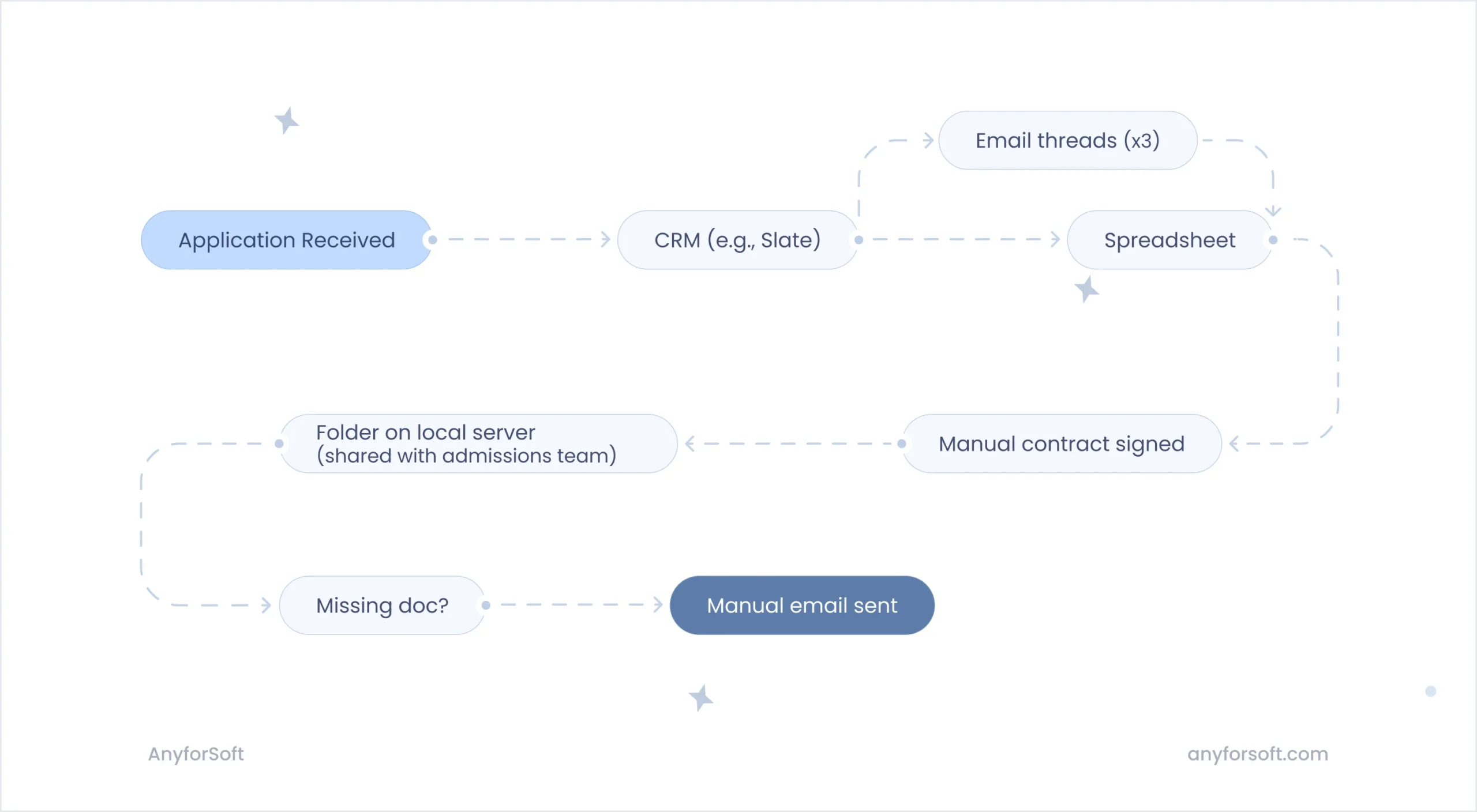
These systems are widespread. But they weren’t built for today’s complexity.
As Kittie Pain, director of graduate admissions at Kutztown University of Pennsylvania, puts it in her interview for Volt, “We do a lot of fitting square pegs into round holes.”
Many off-the-shelf tools focus on the wrong problem — like detecting AI-written essays — while ignoring what staff are actually drowning in: manual follow-ups, incomplete documentation, disconnected systems.
Others assume universities operate with clean, structured workflows. In reality, most admissions teams work across a mash-up of CRMs, spreadsheets, inboxes, and shared folders — a far cry from the promises of higher education digital transformation.
Here’s one response we got in our survey:
“It’s 2025, and we’re still handling contracts manually and storing all candidate data in Excel files. Using AI isn’t an option; investing in the right tool is simply off the table.”
So the real question is not “how do we fight AI in applications?”
It’s “how can we use AI to stay ahead in the chaos we’re already in?”
Let’s unpack where that chaos shows up first.
What Admissions Teams Struggle With?
During peak seasons, the number of applications can reach hundreds of thousands (the real number depends on the institution’s size, reputation, and program variety).
It feels like an avalanche, even with digital tools supporting the process.
“Even with digitized processes, reviewing documents, verifying authenticity, and handling incomplete files still require a lot of manual work. This is especially true for international admissions, where documents follow different national standards and need extra checks.” – Enrollment Advisor at Universidad Europea de Madrid
In this condensed routine, admissions managers not only have to stay afloat and process documents accurately, but also maintain cohort balance and admit exactly the right number of students.
Here are some of the pressures AnyforSoft heard from respondents across the survey:
Manual follow-ups
On average, 40% of an admissions officer’s workday is spent nudging and tracking. That’s hours lost chasing missing documents, confirming file completeness, and sending reminders that CRMs can’t automate.
As one admissions team in our survey put it:
“We are receiving 50–80 emails a day asking: Did you get my document? Can you confirm my file is complete? Is my transcript in?”
These follow-ups are critical to compliance, enrollment pacing, and applicant experience. But the sheer volume — compounded by fragmented systems and last-minute submissions — buries strategic work under a pile of operational fire drills.
Fortunately, with the right AI-powered triggers and document status visibility, manual follow-ups don’t have to dominate the day (read on to learn how).
Incomplete document sets
Incomplete applications stall the entire review pipeline and forces staff into constant checking loops. These gaps create frustration and push deadlines dangerously close.
“One major challenge is chasing missing documents and references; if they aren’t submitted with the initial application, it takes extra time to collect them.” – Admissions tutor, Swansea University
“The biggest challenge is following up on incomplete documents, which demands a lot of manual effort.” – Associate Director of Admissions and International Business Development at EADA Business School
These have ripple effects because reviewers can’t proceed without the full set. In the meantime, applicants grow anxious and flood support with follow-ups, which leads to internal deadlines slipups and pressure at the top of the funnel.
In international admissions, delays from missing references or transcripts also mean missed visa deadlines or entire cohorts falling behind.
Until there’s a system that flags and follows up before a human notices, admissions teams are stuck playing document detective.
Document authenticity verification
Verifying the authenticity of diplomas, transcripts, and recommendation letters is slow and detail-heavy. Officers must confirm each document source, which often involves direct outreach to previous institutions. Errors here can risk admitting unqualified or fraudulent applicants.
“We do all the verification manually. AI could help us cross-check what’s in the portals with what’s actually submitted, but we don’t have the system to support that.” – The team at Università di Padova
One mistake could let a fraudulent or ineligible candidate through — but verifying every line by hand during peak season isn’t scalable. And when international credentials come in late, in unusual formats, or with translation gaps, it turns into a multi-day bottleneck that slows down the entire review chain.
International admissions headaches
International admissions are an engine of growth for many institutions in 2025. But in practice, it often becomes a maze of unclear foreign transcripts, unusual grading scales, and hours spent decoding education systems staff were never trained in.
“Verifying international qualifications can be slow. We often have to visit external databases or websites to research how a student’s credentials compare to our local standards. Each foreign credential means opening a new tab, checking conversion guidelines, and hoping nothing gets misread. And when translations are unclear or inconsistent, staff are left second-guessing decisions they’re supposed to make quickly.” – An admissions officer at Arden University
Until systems can flag outliers, detect language and document types, and suggest likely equivalents, international admissions remains a slow, high-risk guessing game.
GDPR/compliance blockers
Privacy rules demand strict data handling, and every access or change must be carefully controlled. Keeping up with evolving compliance standards eats into already limited staff time. Mistakes here can lead to serious legal and reputational risks.
“I’m conscious that a lot of our students also send passports and things like that. So GDPR and such are very significant issues within admissions.” – As ESCP admission team
With thousands of applications, international documentation (including passports and visas), and multiple disconnected systems, compliance becomes a full-time job layered on top of already overloaded workflows.
Lack of analytics
Even in 2025, many admissions teams still make decisions without the data they need. CRMs may track who clicked what, but they rarely tell you who’s likely to yield, who’s drifting, or which applicants need early intervention.
“We confirm enrollment, but don’t really know how prepared students are until they show up,” one admission officer told AnyforSoft.
And that often translates into missed targets:
- Scholarship candidates overlooked
- Weak academic signals ignored
- Engaged students lost mid-funnel because no one flagged them as ready
Without reliable analytics, enrollment planning becomes educated guesswork. Yield forecasting slips. Resource planning lags. Cohort quality becomes a post-arrival surprise.
High-volume review fatigue
On average, a manager has just 5–10 minutes to process each application package. That’s just enough time to skim transcripts, scan recommendations, check for completeness, and make a call that could shape an entire cohort.
Now imagine doing that 60 times in a day.
Every day, they work through dozens of these packages in a relentless flow. With each round, attention fades; critical details slip by unnoticed.
This isn’t just a productivity issue. It’s a risk multiplier. Fatigue-driven decisions mean the wrong admits, the wrong rejections, and lost opportunities for the people who might’ve changed the class dynamic.
Overall burnout
“Everyone’s already working weekends when files start flooding in.”
Continuous overload pushes staff to emotional and physical limits. The flood of follow-ups, the broken workflows, the compliance checks, the unanswered emails — they don’t stop.
And behind every one of those tasks is a person who hasn’t taken a proper lunch break in three weeks.
Burnout doesn’t just mean stress. It means slower decision-making, increased error rates, shorter fuses with applicants, and an exodus of experienced staff who take institutional knowledge with them.
When admissions teams are burned out, both applicant experience and long-term outcomes suffer.
Practical Use Cases for Admissions AI
Let’s look at how specific AI tools and solutions can tackle challenges through smart automation. The most effective implementations leverage both generative AI vs predictive AI capabilities strategically.
Smart follow-up triggers
Remember that inbox chaos admissions teams described? AI can help stop it at the source.
With automated follow-ups, each applicant gets timely confirmations — “We received your transcript” — or nudges when something’s missing. That alone can cut inbound email by half or more.
But the real value is behind the scenes.
Instead of urgent pop-ups, staff receive organized alerts based on urgency and context — acting like an assistant, not an interruption.
The AI-based smartest setups adapt to two things:
- Context, like prioritizing international files with document compatibility issues or re-engaging quiet applicants with a reminder about scholarships. You can trigger re-engagement prompts when previously engaged applicants suddenly go quiet, — for example, messages with a quick recap of the scholarship opportunities.
- Timing, like sending calm follow-ups early in the season, and rapid alerts when deadlines are near to avoid missing enrollment targets.
As a result, those daily email floods become occasional trickles, and staff attention shifts from constant firefighting to strategic work.
Smart follow up trigger scenarios: Who gets what and when
| When This Happens | Student Experience | Staff Experience |
|---|---|---|
| Transcript uploads successfully | Immediate confirmation: “Your transcript from State University has been received and verified” | Background update to applicant file – no interruption needed |
| International document needs translation | Specific guidance: “Please submit a certified English translation using our approved translator list” | Alert with document type and requirements for follow-up |
| Previously engaged applicant goes quiet | Gentle re-engagement: “We noticed you haven’t logged in recently. Here’s what’s still needed to complete your application” | Early intervention flag: “High-potential applicant showing drift risk” |
| Document format looks suspicious | Clarification request: “We need a clearer copy of your diploma. Please re-upload using these guidelines” | Priority review alert with specific authenticity concerns flagged |
| Deadline approaching with incomplete file | Urgent but helpful: “You have 3 days to submit your recommendation letters. Here’s how to send reminders to your recommenders” | Automated task creation for possible deadline extension case |
Document classification & completeness checks
Diplomas to this folder, recommendation letters – to this one, transcripts over here, ID copies there, financial statements in another pile… An admissions manager becomes both a detective and an archivist.
AI document classification can sort our even unstructured documents and work with all possible formats. After files are instantly sorted, they’re checked against program requirements. Missing files trigger automated follow-ups before staff even notice the gap.
Staff see organized, pre-processed information instead of raw files requiring interpretation.

Authenticity checks & fraud detection
Even a seasoned admissions manager can’t say with 100% confidence if documents are authentic.
AI document classification “knows” what legitimate diplomas and transcripts should look like, based on document structure, formatting standards, and historical patterns. It might flag unexpected font changes, inconsistent branding, or grade calculations that don’t match a school’s typical output.
When something looks off, the system sends a focused alert.
This doesn’t eliminate human judgment but rather amplifies it. Instead of manually inspecting every document, reviewers can zero in on genuinely questionable submissions.
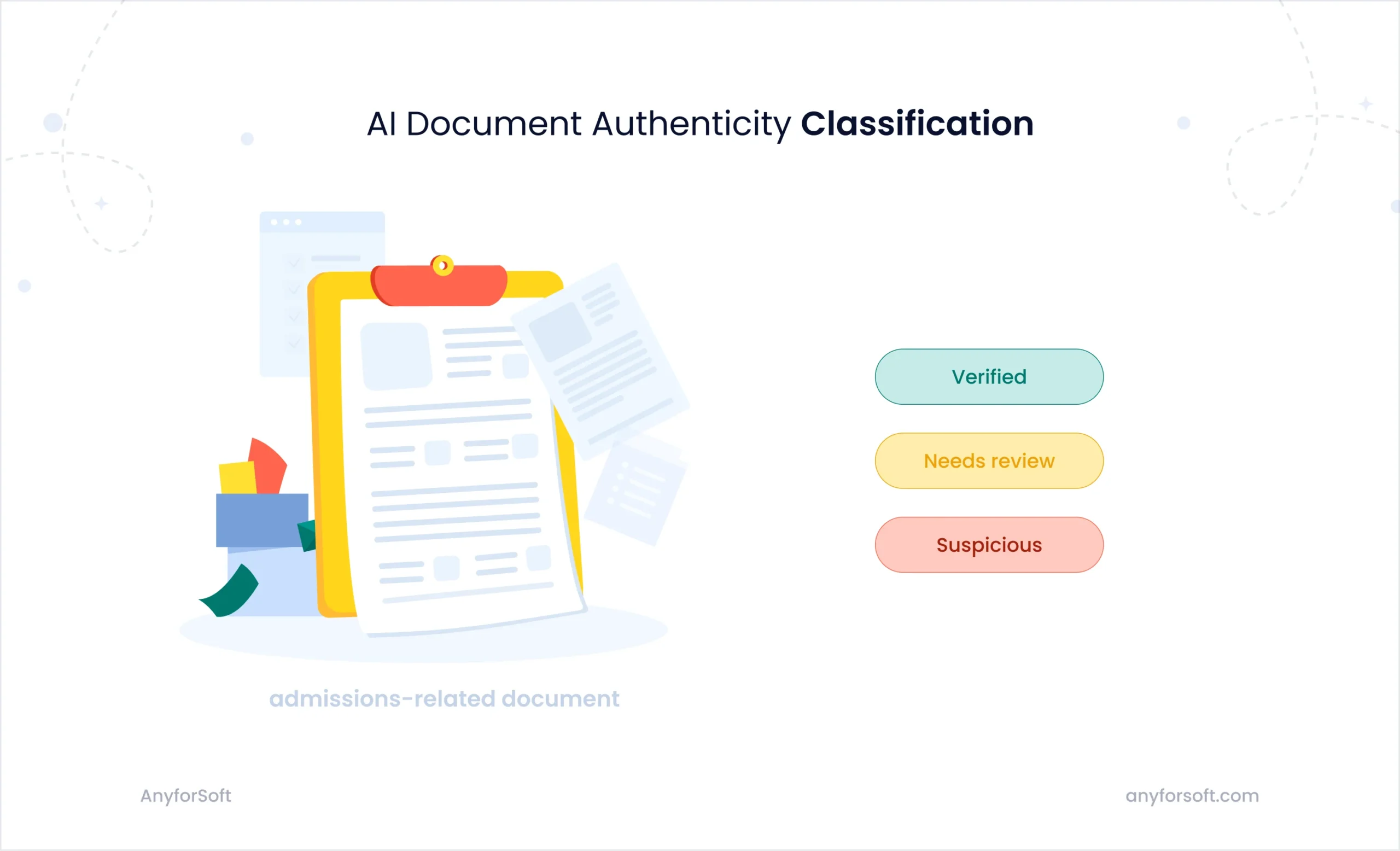
Language detection & standardization for international admissions
Each foreign transcript means opening new tabs, checking conversion guidelines, and hoping critical details don’t get lost in translation.
AI language detection and standardization tools eliminate most of the manual research overhead.
When international documents arrive, the system automatically detects the language, translates key sections, and maps grades to local equivalents using trusted conversion tables.
Instead of raw PDFs that need interpreting, staff see standardized summaries. A 16/20 grade from France, for example, displays as a local A–. If a document uses an unusual scale or contains translation gaps, it’s flagged for manual review.
Instead of constant research — standard review workflow, in which routine conversions happen under the hood. Staff can evaluate international and domestic applications using the same criteria and timeframes.
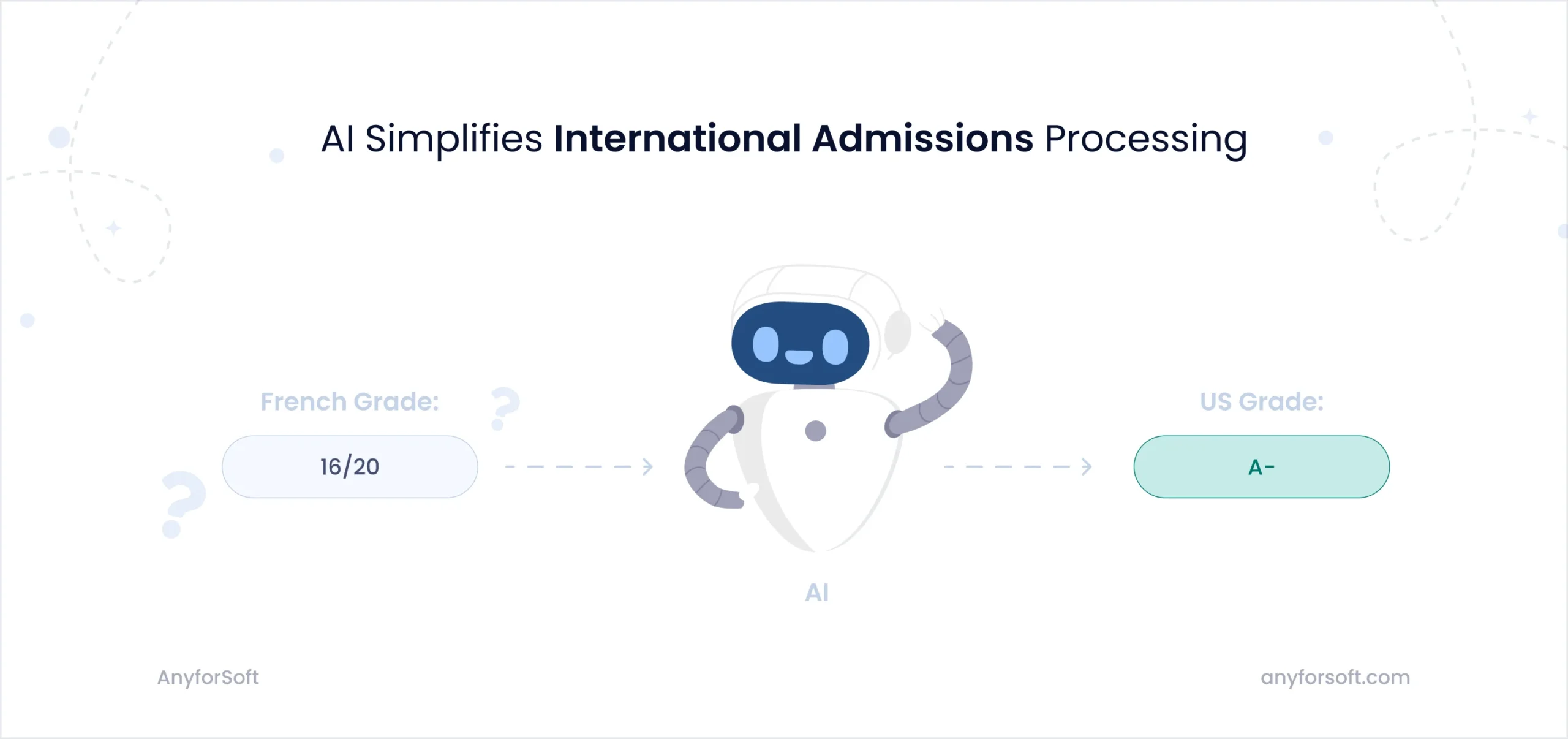
Secure, role-based document access
Every European university is understandably cautious about GDPR compliance, and rightly so. Universities handle some of the most sensitive personal data out there. So obviously, connecting any AI to a third-party API is risky territory.
Role-based document access provides a balance between 100% compliance and fast document processing by making compliance automatic.
- Financial aid officers see aid-relevant documents but won’t be able to access recommendation letters.
- Admissions reviewers get full application access during active review periods.
- International student coordinators access visa documents and language certificates but not personal essays.
All access gets logged automatically for audit requirements.
Some universities go even further — using self-hosted AI assistants that flag discrepancies without sending any data outside their systems. That means zero risk of third-party exposure, and full compliance from day one.
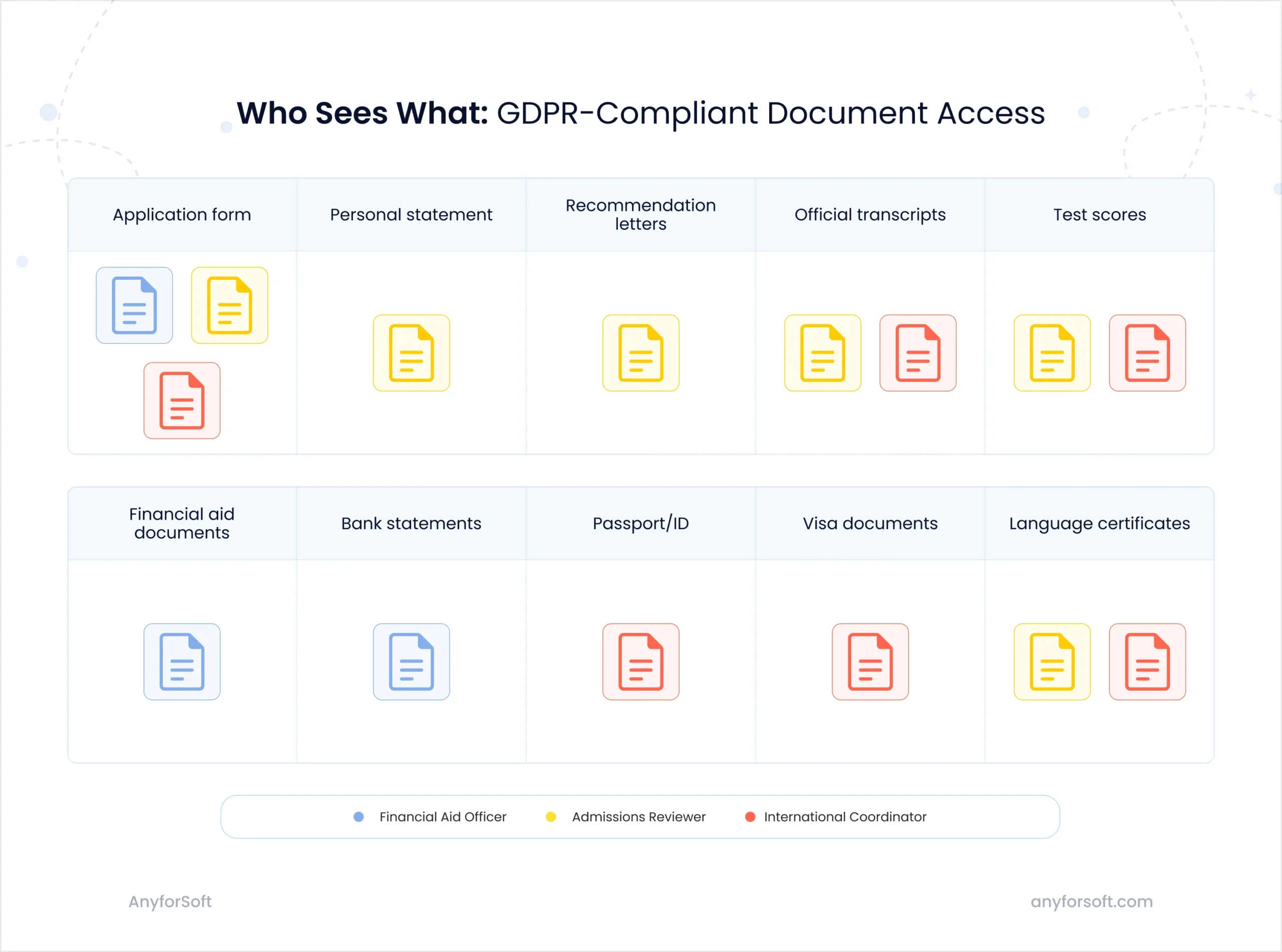
Early engagement scoring & readiness flags
CRM collects a lot of helpful information, yet AI derives deeper insights. These insights help admissions teams target their attention — and scholarship dollars — on students who show genuine interest and strong motivation.
The difference becomes clear when you see AI in action.
| Criterion | CRM Analysis (Surface Level) | AI Analysis (Deep Level) |
|---|---|---|
| Portal Activity | Tracks total login frequency and page views | Analyzes time spent per page, navigation patterns, and content depth. Does the student spend 2 minutes on the homepage or 20 minutes reading course descriptions? |
| Communication Engagement | Measures email open rates and click-through rates | Evaluates response timing, question quality, and conversation progression. Generic questions vs. specific ones about curriculum and career outcomes? |
| Event Participation | Counts attendance at virtual info sessions | Tracks active participation—asking questions, staying for full duration, attending follow-up sessions vs. logging in briefly and leaving |
| Document Interaction | Records which brochures were downloaded | Monitors reading behavior—which sections students focus on, return visits to re-read, program-specific vs. general information downloads |
| Research Patterns | Lists which website sections were visited | Maps logical research flow—progression from general program info → specific courses → faculty research → career services vs. random browsing |
Instead of spreading scholarship offers equally among all qualified applicants, admissions teams can identify students who demonstrate genuine commitment to enrollment and academic success.
Does a student explore specific course requirements and ask detailed questions about career outcomes? This person shows deeper commitment than someone who casually browses and asks generic questions.
This targeting transforms both efficiency and outcomes. Schools report higher yield rates on scholarship offers because they’re reaching students who were already leaning toward enrollment.
More importantly, these students tend to be more engaged campus community members and show stronger academic performance. This is exactly the kind of cohort quality that admissions teams aim for but rarely achieve through traditional selection methods.
Applicant segmentation
Remember the avalanche that overwhelms managers who have to analyze hundreds of candidates per day? Now, imagine that you have an intelligent traffic control system.
With this technology, you build a complex yet manageable system of lanes. All applications don’t hit the same overwhelmed intersection. Instead, each follows their lane.
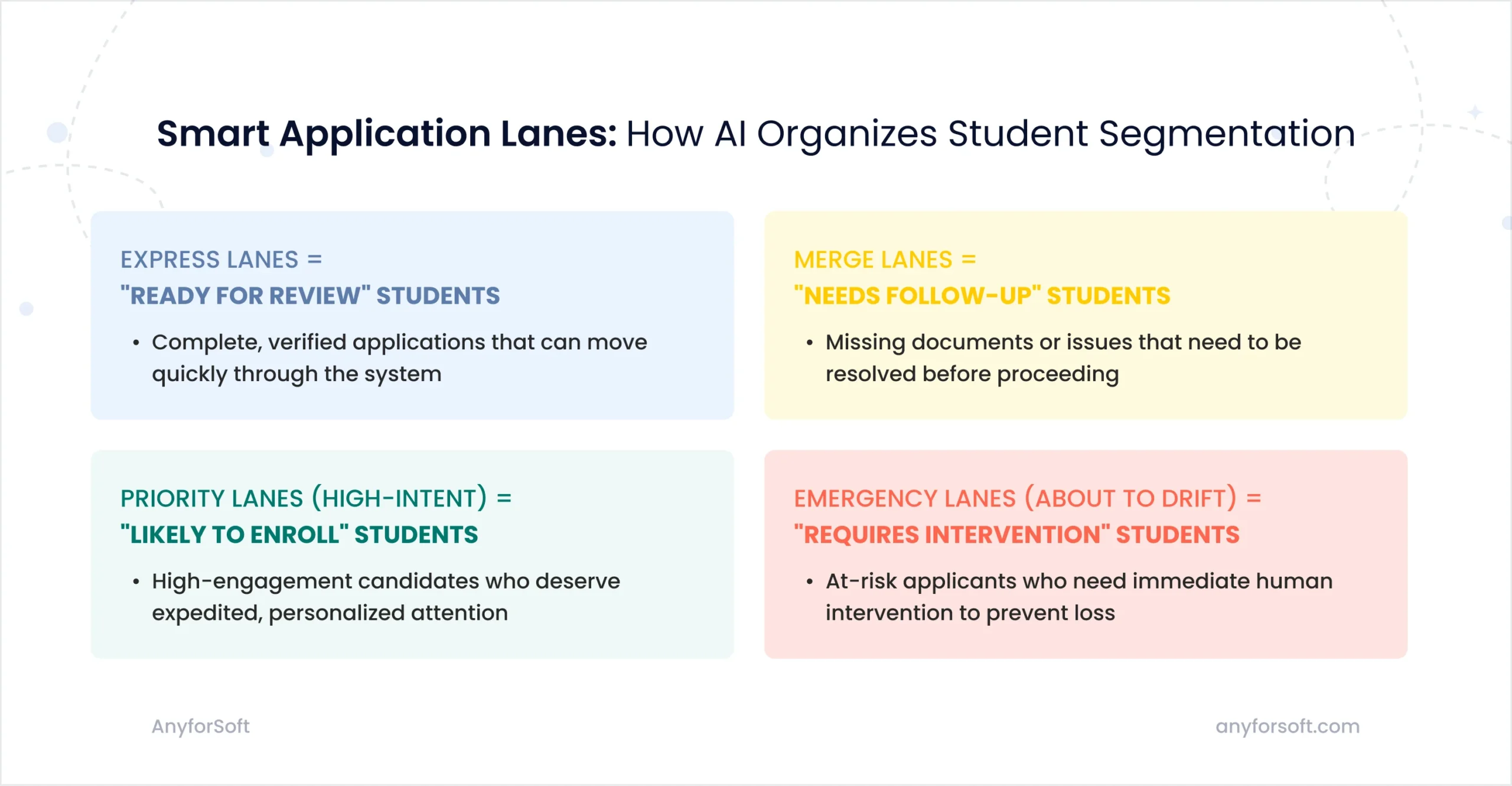
How does AI match lanes and students? It intelligently manages the data we provide through CRM, SIS, and uploaded documents.
Here is a breakdown of information pipelines:
- Document completeness algorithms scan against program-specific requirements.
- Engagement pattern analysis compares current behavior to historical enrollment data.
- Timeline tracking identifies students approaching critical deadlines.
- Risk scoring combines multiple factors to predict likelihood of application abandonment.
- Academic fit matching evaluates if credentials match program standards.
This technological approach transforms the daily workflow from “Where do I even start?” to “Here are the five applications that need immediate attention, and here’s why.”
Strategic focus & capacity protection
Does automation come down to enhanced productivity only? Yes, but that’s just one side of the coin. The other side is protecting human expertise for work that actually requires human judgment.
Think about it: admissions professionals didn’t enter this field to chase missing documents or send follow-up emails. They became admissions officers to shape incoming classes, identify exceptional candidates, and build communities of learners who will thrive together.
- At Oxford University, the Student Fees and Funding team achieved a 55% reduction in manual steps for each application through workflow automation.
- At Flinders University in Australia, AI-based automation helped staff save more than 1,800 hours annually on managing award letters for high-achieving students.
“Automation eliminates hours of manual work for logging documents, sending emails, and preparing reports. This gives a team more capacity for the casework that actually helps students, and the team can respond much faster without being trapped by administrative bottlenecks.” – Florence Ledger from Oxford University
While these examples aren’t admissions-specific, they demonstrate the transformative potential of automation across university operations. If teams can achieve 55% efficiency gains and save thousands of hours on financial aid and award processes, the impact on admissions workflows could be equally dramatic.

What AI in College Admissions Can Look Like in Practice
Let’s find out how AnyforSoft integrates AI into admissions workflows.
With deep experience in building and connecting complex systems like SIS and LMS platforms, our team ensures each AI feature integrates smoothly, meeting compliance standards and minimizing disruption across your tech ecosystem.
In a recent LMS modernization project, our approach resulted in significant improvements. The client’s team observed significant gains in learner engagement and completion rates, improved user satisfaction, and notably more efficient content management processes.
How AI processes applications from start to finish
The AI-ruled workflow revolves around four key components:
- Input and output.
- Data processing.
- Built-in decision-support.
- Automated triggers.
The solution’s architecture includes two essential layers:
- The automation layer, which you’ve already seen in action, powering reminders, file checks, and smart routing.
- The analytical layer, where data is stored and transformed into real-time insights.
The analytical layer unlocks the strategic power of admissions AI. While the application automates routine, it also collects data that can be used by admissions staff to uncover trends, predict yield, adjust recruitment strategies, and make better cohort decisions based on real-time insights.
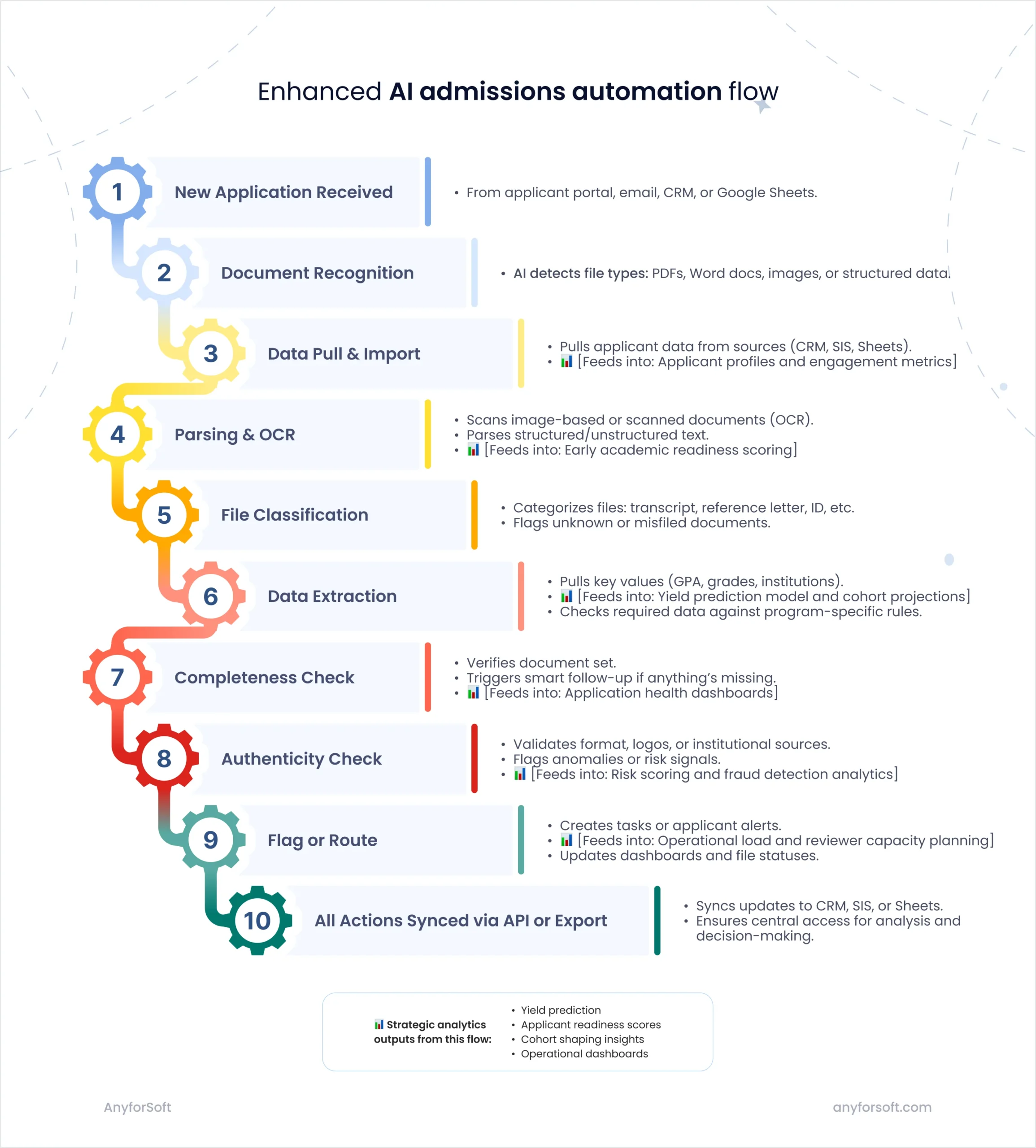
What looks like a linear, static process in the scheme is actually dynamic and iterative. As soon as new data arrives, the AI system re-evaluates document status, updates completeness checks, adjusts applicant scoring, and may trigger new follow-ups or alerts.
This way, the process stays continuously responsive and up to date.
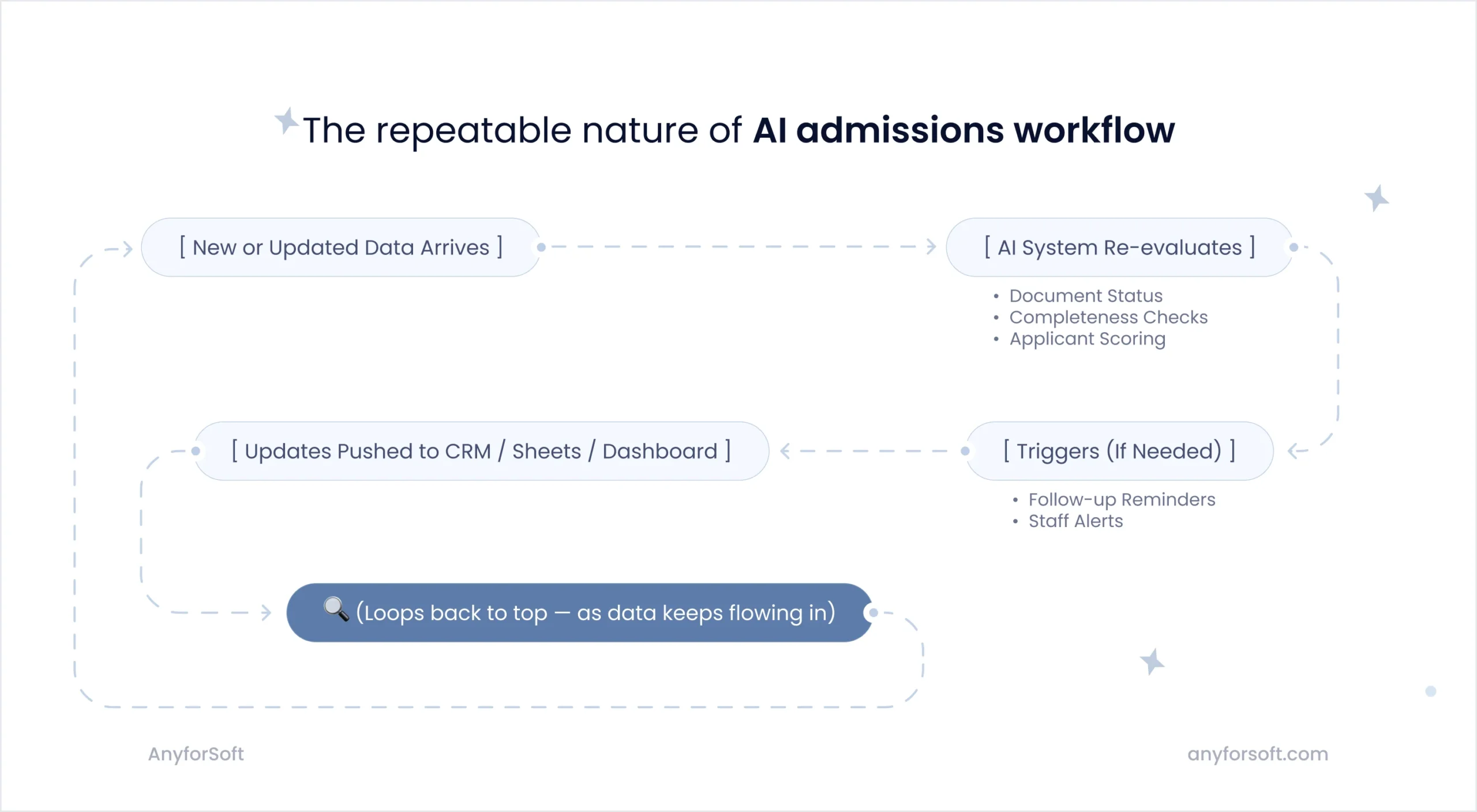
Smart differentiation: How AI handles bachelor’s, master’s, and PhD applications
The system adapts to different admission flows for various educational levels: Bachelor’s, Master’s, and PhD. The system automatically applies appropriate evaluation criteria for each program level without requiring manual configuration or separate workflows.
“Different education levels come with different review flows — and we design AI systems that reflect that. Whether it’s research depth for PhDs or academic readiness for undergraduates, the logic adapts to each program without requiring separate workflows.” – Oleg Bogut, CTO at AnyforSoft
This means admissions teams can focus on criteria truly relevant to each program: research experience for PhDs, professional background for Master’s, academic readiness for Bachelor’s.
Meanwhile, applicants receive a personalized experience with program-specific guidance and document requirements. All of this is delivered automatically without additional staff effort.
| Bachelor’s | Master’s | PhD | |
|---|---|---|---|
| Document requirements | TranscriptsTest scoresRecommendation lettersPersonal essays | Professional referencesWork experience lettersStatement of purposeAcademic transcriptsPostgraduate degree documents | Research proposalsAcademic publicationsDetailed CVFaculty endorsementsAcademic writing samples |
| Evaluation | Standardized test scoresExtracurricular activitiesAcademic readiness | Professional experienceCareer progressionProgram-specific prerequisites | Research experiencePublicationsMethodology proposalsAcademic references |
| Communication | “Your SAT scores have been received. Please submit your personal essay to complete your application.” | “We’ve received your professional references. Your work experience documentation is still needed.” | “Your research proposal is under review. Please ensure all publication PDFs are properly formatted.” |
Decision-making AI beyond simple task automation
An AI-powered admissions solution might act as an autonomous decision-maker, guiding each application through decision points that determine the next step.
This is the core of agentic AI — an approach based on intelligent “agents” that can complete entire workflows independently, only involving humans when complex judgment is required.
“Agentic AI follows full decision chains. It checks, routes, escalates, and moves applications forward without waiting for human input at every step. That means fewer people stuck on routine paperwork, faster document flow, and more human time focused on the edge cases where real judgment is needed.” – Oleg Bogut, CTO at AnyforSof

Takeaways: The Role of AI in College Admissions
AI significantly reduces the time admissions officers spend on routine tasks. This efficiency gain is measurable and quantifiable. Here’s a calculation you can customize with your institution’s specific numbers.
Say your admissions manager spends 3 hours a day on follow-ups, document checks, and chasing missing info. That’s 15 hours per week — nearly 40% of a standard workweek.
Now imagine reclaiming that time.
What could it go to instead?
- Spotting high-potential candidates early.
- Fine-tuning cohort diversity and academic balance.
- Planning scholarship distribution with data in hand.
As AI and college admissions continue to evolve, the technology frees up human capacity, allowing admissions professionals to do what only they can — make the nuanced decisions that shape the quality of each incoming class.
FAQs
No, AI won’t replace your admissions staff. Instead, it automates repetitive tasks like document tracking and follow-ups, so your team can focus on higher-value work, like evaluating applicants, shaping cohorts, and improving enrollment strategies. AI acts as an assistant, not a substitute.
No, it won’t. AI tools can be designed to fully comply with GDPR and other privacy regulations, addressing common concerns about AI data privacy in higher education. Access to applicant data is controlled by user roles, monitored through activity logs, and limited in duration. AnyforSoft ensures that all implemented solutions meet strict data security and compliance standards.
It depends on the scope. Adding an AI layer is often more cost-effective than full system replacement, especially when built on top of your existing SIS or CRM. AnyforSoft can help you estimate the cost based on your current tools, team capacity, and admissions volume.
Timelines vary by complexity. A proof of concept can be ready in a few weeks, while full rollout typically takes 2–3 months for a mid-sized institution. AnyforSoft ensures each step fits your tech ecosystem and admissions cycle.








